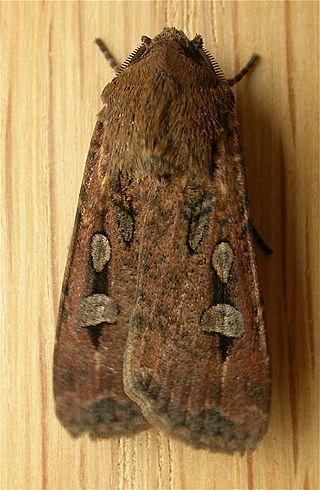
The bogong moth is a temperate species of night-flying moth, notable for its biannual long-distance seasonal migrations towards and from the Australian Alps, similar to the diurnal monarch butterfly. During the autumn and winter it is found in southern Queensland, western New South Wales, western Victoria, and also in South and Western Australia. Adult bogong moths breed and larvae hatch during this period, consuming winter pasture plants during their growth. During the spring, the moths migrate south or east and reside in mountains such as Mount Bogong, where they gregariously aestivate over the summer until their return towards breeding grounds again in the autumn.

The brown-banded antpitta is a vulnerable species of bird in the family Grallariidae. It is endemic to Colombia.

Horisme vitalbata, the small waved umber, is a moth of the family Geometridae. The species was first described by Michael Denis and Ignaz Schiffermüller in 1775. It occurs in Europe.

Brithys crini, the amaryllis borer, crinum borer, lily borer or Kew arches, is a moth of the family Noctuidae. It is a garden pest in parts of its range, as their larvae damage the stems and leaves of lilies, especially lilies of the family Amaryllidaceae.

Menophra is a genus of moths in the family Geometridae erected by Frederic Moore in 1887.

Agriopis aurantiaria, the scarce umber, is a moth of the family Geometridae. It was first described by Jacob Hübner in 1799 and it is found throughout Europe from Spain through Central Europe to Russia. In the south it can be found from the western Mediterranean to the Black Sea and the Caucasus. Its northern distribution reaches as far as central Fennoscandia. The species can be found in many different places, including deciduous forests, orchards, gardens as well as parks and settlement areas.

Zanclognatha dentata, the coastal plain zanclognatha, is a litter moth of the family Erebidae. The species was first described by David L. Wagner and Timothy L. McCabe in 2011. It is found in North America from Ontario to Nova Scotia, south through the Great Lake states and in the Appalachians to northern Georgia. One specimen from a sandhills area in central South Carolina also appears to represent Z. dentata.
Stygionympha robertsoni, or Robertson's brown, is a butterfly of the family Nymphalidae. It is found in South Africa, in Northern Cape, the southern part of Free State, the northern part of Western Cape and the Eastern Cape.
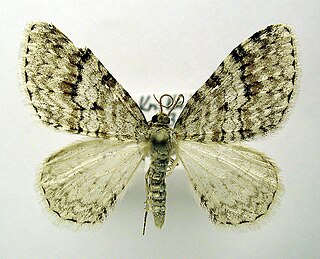
Venusia cambrica, the Welsh wave, is a moth of the family Geometridae. It is found in Europe, western and central Siberia, Altai, Transbaikalia, the Russian Far East, the Korean Peninsula, Japan and in North America, where it can be found across Canada from Newfoundland and Labrador to British Columbia, south in the west to California, south in the east to Georgia.
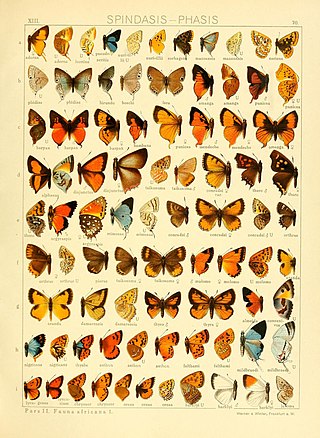
Aloeides molomo, the molomo copper, is a butterfly of the family Lycaenidae. It is found in southern Africa.

Epione vespertaria, the dark bordered beauty, is a moth of the family Geometridae.

Hydrelia flammeolaria, the small yellow wave, is a moth of the family Geometridae. The species was first described by Johann Siegfried Hufnagel in 1767 It is found in most of the Palearctic realm, from western Europe to Japan.

Lampropteryx suffumata, the water carpet, is a moth of the family Geometridae. It is found from Europe to the Altai Mountains, Khabarovsk Krai and the Kamchatka Peninsula in the far east of Russia, and Hokkaido, Japan. In 2000, the species was discovered in Alaska, USA, and then in 2008 DNA-barcoding analysis of museum specimens identified several Canadian specimens, thereby extending the geographical range from Ireland in the west, across Eurasia, to the west of North America. The habitat consists of damp woodland, grassy areas, chalk downland and scrubland.

Philereme transversata, the dark umber, is a moth of the family Geometridae. It is found in much of the Palearctic realm.
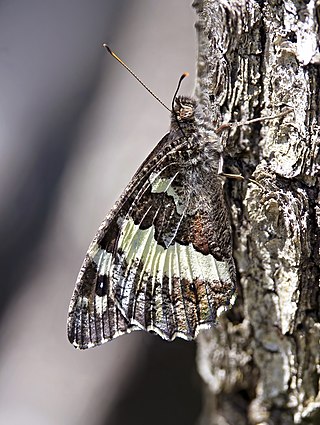
Brintesia is a monotypic butterfly genus in the family Nymphalidae and subfamily Satyrinae. Its one species is Brintesia circe, the great banded grayling.
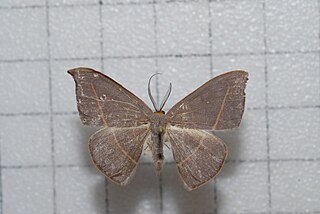
Microblepsis violacea is a moth in the family Drepanidae first described by Arthur Gardiner Butler in 1889. It is found in north-western and north-eastern India, Taiwan and China.

Parastichtis suspecta, the suspected, is a species of moth in the family Noctuidae. It is found from most of Europe through Russia and east through the Palearctic to Japan. It is also found in North America.

Lon melane, also known as the umber skipper, is a butterfly of the family Hesperiidae. It is found in California, southern Arizona, Baja California, the highlands of Mexico and Central America. The habitat consists of desert foothills, grassy areas, streamsides, roadsides, yards, parks and open oak woodland.
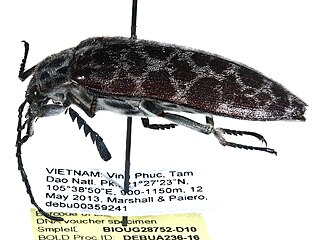
Eulichadidae is a family of beetles belonging to Elateriformia. There are two extant genera, Eulichas with several dozen species native to the Indomalayan realm of Asia, and Stenocolus, with a single species native to Western North America. The larvae are aquatic, with the larvae of Eulichas being found in sandy sediments of clean forest streams, while the larvae of Stenocolus are found under rocks and in leaf packs in low elevation streams and rivers. They are herbivious/saprophagous with larval specimens of Eulichas having been found with wood particles in their stomachs, while the larvae of Stenocolus are known to feed on decaying roots and detritus. The adults are terrestrial, with specimens of Eulichas typically found using light, while specimens of Stenocolus are typically found in riparian vegetation, and are not attracted to light. Potential extinct genera have been described from Mesozoic rocks, but the placement of several of these taxa in the family is disputed.






















